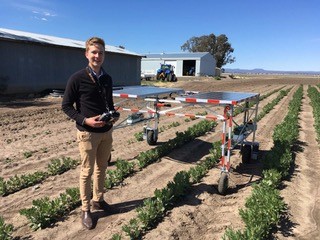Weed control in ginger production systems is reliant on labour intensive spot-spraying and hand pulling, resulting in significant financial and production risk in the timely management of weeds. Guy’s research (funded by AgriFutures™ Ginger Program) aims to overcome these issues through the development of an automated, site-specific spot spraying platform integrating machine learning and robotics. Additionally, alternative control options will be investigated with the aim of identifying non-chemical automated weed control options for ginger cropping systems.
Why is this research important?
Weeds can reduce ginger yields by up to 80%. To avoid these yield losses, weeds are controlled via manual spot-spraying that is highly labour intensive and costly, resulting in weed control costs of between $3,000 and $5,000 per hectare. Such a significant investment in control creates financial and production risks for the growers, restricting the expansion of the industry. Given the large threat weeds pose to viable production, and the risks inherent in substantial labour requirements, an alternative approach to weed control is needed.
Automation and the implementation of machine learning algorithms are clear candidates to improve production efficiency and reduce these risks in the industry. Any reduction in control cost or improvements in efficiency and timing can have significant flow on benefits, creating opportunities for the growers to improve profitability and the industry to expand. This project seeks to develop an automated weed control module to suit autonomous platforms, offering continuous management options and helping address these key issues hampering ginger production. The project will explore the development and implementation of non-chemical weed control alternatives, placing ginger growers at the forefront of weed science and management techniques.
Why and or how did you get involved in the project?
As a precision weed control scientist, projects involving weeds and technology always pique my interest. Prior to submitting an application, the Weeds Research Team in Narrabri visited ginger growers in Queensland, scoping out the problems, production systems and how robotics and machine learning might be used to address weed problems. Through our discussions with growers, we saw substantial opportunity for practical automation in ginger production systems with raised beds, wider crop spacings and strong crop-weed differences in colour, distribution, architecture and features discernible with machine learning algorithms. Coupled with grower-led interest and ideas, the project is an exciting confluence of weed science and technology with opportunities for impactful outcomes.










